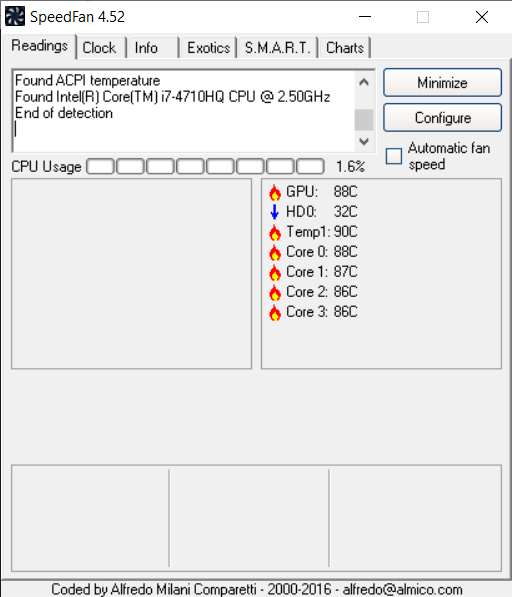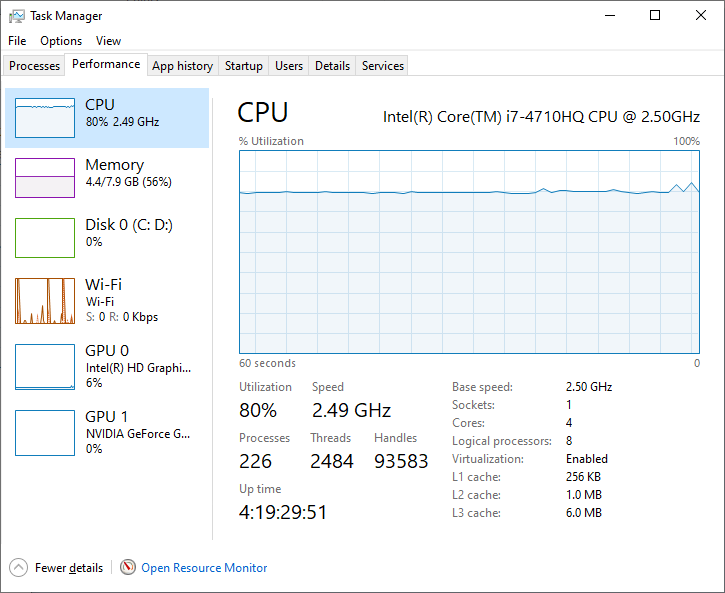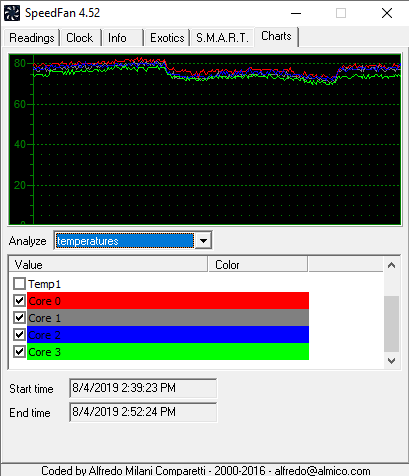Laptop cooling pads are one of many cost effective methods you can use to improve the performance of your laptop. But how good are they?
If you are considering to buy a laptop cooling pad, then I would recommend that you read this guide first in order to choose the best option for your laptop.
What are laptop cooling pads?
Laptop cooling pads such as the popular Carantee Laptop Cooling Pad are kind of mini platforms for your laptop but with fans integrated into them.
The principle behind them is simple. The pad takes in cool air from under the pad and blows it right into your laptop. This in theory should help keep your laptop a few degrees cooler.

The other argument is that the laptop is also raised a few inches from the table or desk, so there is less heat “trapped” under the laptop. Since the pad is usually a porous surface and there is constant airflow created by the fans, there should be much less of a heat trapping effect. This should also help keeping your laptop cool.
Putting cooling pads to the test
Everything sounds good so far. You might be wondering, if those cooling pads really help your laptop temperatures.
Well, we decided to put this to the test by taking temperature measurements to find out if the cooling pad really makes a difference.
For our experiment, I used my good old Lenovo 15 inch Y50-70 laptop with a Chinese MECO Laptop cooler that I had picked up a while back.
We will perform two tests. First we will put the GPU under heavy load and measure the temperatures. Then, we will place the laptop on the cooling pad and turn it on to see if we experience a drop in temperatures.
We will then do the same steps again but with a CPU load. The reason we do the two tests is because the CPU and the GPU are usually located in different locations of the laptop, so the cooling effect might vary (or not).
Below are the specs for our test laptop:
- Graphics card: GTX 860M
- CPU: Intel Core i7-4710HQ
- Laptop thickness: 23.9 mm or 0,9409449 inches
Please keep in mind that this laptop is known to overheat. I am speaking from both personal experience and other user reviews. So the results of this test should be quite interesting for those who also have overheating or throttling laptops.
Placing the GPU under load with no pad
The GPU was placed under load by running a hashing algorithm. The readings from the temperature sensors were taken using SpeedFan.
After the temperatures have stabilized, the GPU topped out at 88°C. The CPU also reached a temperature of 86.75°C.
Notice that the CPU temps have also increased even though it was not under load. This is because of the close proximity between the GPU and the CPU. The GPU and CPU also share the same heat sink, so a rise in temperature in one place will increase the temperature in the other.
Placing the GPU under load with the cooling pad on
Once the temperatures have stabilized, the laptop was then placed onto the pad, and the pad was turned on. The fan speed of the cooling pad was turned on to the maximum in order to measure the full cooling potential.
Within 10 minutes, the temperature of the GPU has dropped from 88°C to 82°C. That is a 6°C difference.
The average temperature of the CPU has also dropped to 83.5°C. More than a 3 degrees difference.
Placing the CPU under load with no pad
Testing the CPU was a bit more tricky because the CPU throttled quite quickly. We noticed that the CPU tried to keep the temperatures around 80°C while lowering the clock speeds to maintain that temperature.
The result was that the CPU was running at 1.8GHz.

Placing the CPU under load with the cooling pad on
Once the cooling pad was turned on, the CPU was able to maintain its temperatures, but with a clock speed of 2.5 GHz instead of 1.8 GHz. This is a 0.7 GHz performance difference.
Notice in the temperature graphs that the temperatures still hovers around 80°C.
Noise levels
In order to measure the noise level, I thought it would be fair to measure the noise of just the cooling pad. This is because the laptop was actually louder than the pad!. It would also make sense to see how much of a difference in noise the pad would make without interference from the laptop fan.
On average, the noise level rose from 40dB to 45dB, which is still in the quite room territory. Please also keep in mind that this pad is close to 2 years old. A newer pad will achieve even better noise levels.
Test Conclusions
From our tests, we can see that laptop cooling pads actually do work and help to lower temperatures. And lower temperatures translate to better performance and less throttling.
There are a lot of ways to lower temperatures and improve performance, however, a cooling pad is one of the easiest and least complicated ways to do that. There are a lot of advantages to using a cooling pad
- They are cheap to buy.
- They make a remarkable difference in thermal performance.
- They improve performance without needing to open up your laptop and voiding the warranty.
- There is a very low risk for making mistakes or damaging your laptop.
How to choose a cooling pad

Choosing a cooling pad can be a bit tricky, and you will need to keep an eye out for a few things:
- Cooling capacity: How many fans does the cooling pad has? what is the maximum rotation speed in RPM? a higher RPM means more cooling.
- Power source: Is it a USB powered or does it need a separate power cord?
- Adjustability of the fan speeds: Can you lower fan speeds? for example to reduce the noise produced?
- Noise: Is the product noisy? Most modern pads operate quietly.
- Adjustable position: Can you tilt the pad to have a more comfortable screen view and access to the keyboard?
- Size: Make sure that the pad is designed for your laptop size. Otherwise, you will not get the best out of your pad.
I have been using the MECO cooling pad for over a year now, and have been satisfied as it fulfills all the points mentioned before. It also worked very nicely to lower temperatures and improve my laptop’s performance. However, it has since disappeared from the market. However, you could get a TopMate TM-3 12-15.6″ , which I think is a more known brand and would deliver better performance.
If you have a larger laptop, then I recommend the Pccooler Laptop Cooling Pad (click to check the price on Amazon) as it fits laptops up to 17.3 inches, while also providing a fan speed adjustment option.
Who needs a cooling pad
Answering this question can be a bit tricky, and ultimately is up to each individual.
As you have seen, cooling pads will not break the bank. So if you do not have one, it certainly will not hurt to have one on your desk for those hot summer days.
Personally, there are a few things that make me favor a cooling pad, regardless of weather a laptop is old / overheats, or not.
First, having your hardware run a few degrees cooler is not only better for performance, but for the longevity of the product. So even when I am using a newer laptop, I usually like to have it running on a cooling pad.
Another thing to consider is that when your laptop is running cooler, your internal laptop fans do not need to spin as hard, which may reduce the dust build-up around your internal laptop fans and air vents.
If you are planning to overclock your laptop, then extra cooling is a must. This is because your laptop was released with an already pre-calculated thermal energy flow capacity. Overclocking your hardware pushes those designs to the limits, and it is crucial to have extra cooling to make sure that temperatures do not go too far.
Others who can benefit from a cooling pad are those with powerful laptops which tend to overheat. This usually happens because manufactures are increasingly trying to squeeze in more and more powerful hardware, in increasingly thinner laptop cases. Putting an incredibly thin laptop with high specs is very good for catching the attention of consumers. However, trouble starts when this powerful hardware is used at full capacity.
Another category of users who could benefit from a cooling pad are users with older laptops and laptop designs. If you are not yet prepared to throw out your old laptop, but are having issues with heat and performance, then you will sure benefit from a cooling pad. Also make sure to take a look at our guide for different ways to improve laptop temperatures and performance.
If you have a new laptop with relaxed temperature ranges, then you can probably keep off buying a cooling pad for yourself, or you can instead buy it for a friend or a colleague who might benefit more from it.
Summary
In this post, we discussed how the benefits of using a cooling pad. We set up a performance test to benchmark the temperatures of the CPU and GPU to see if a cooling pad does bring in a benefit.
If you liked this post or have any questions, then please let us know in the comments section.







Leave a Reply
You must be logged in to post a comment.